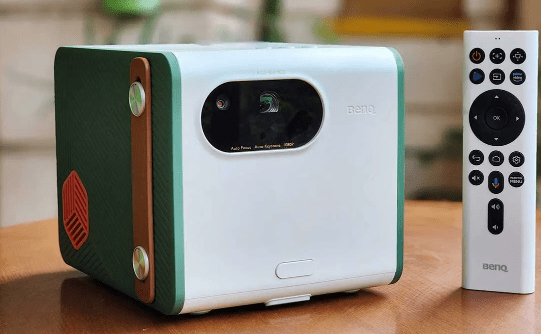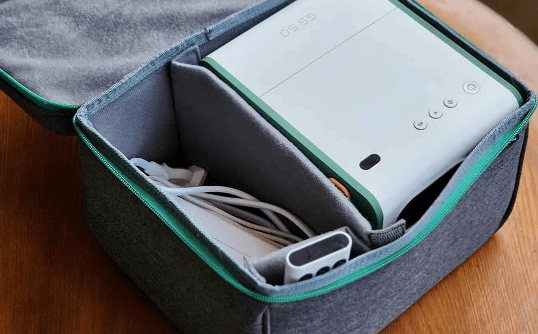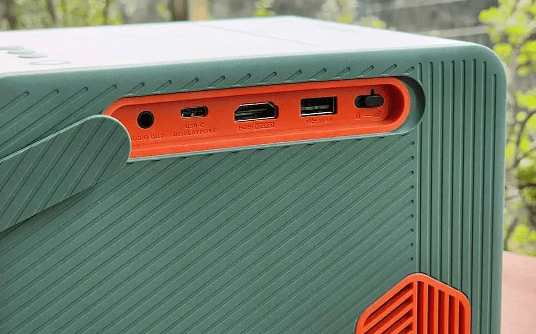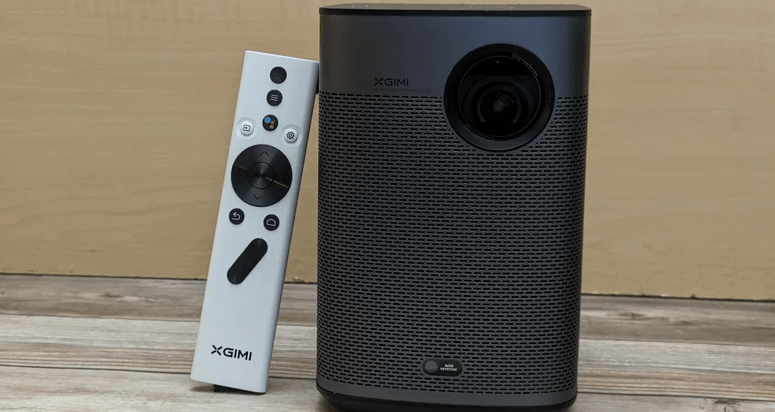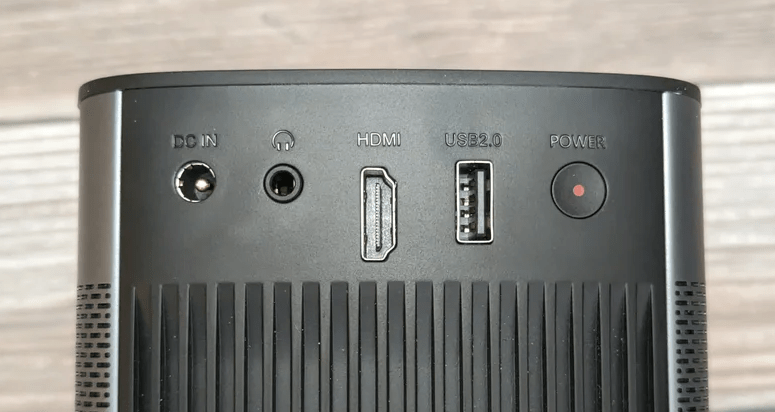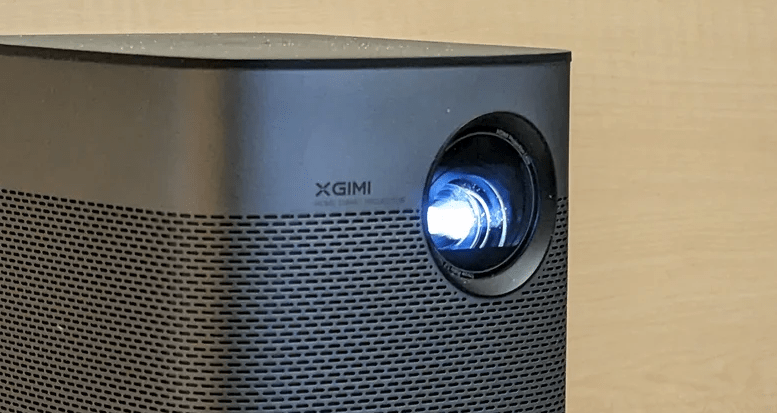At gagadget.com, your trust is our priority. We follow strict quality standards in our research, tests, and analysis of video projectors, to give you the best experience. Learn more
BenQ GS50 vs XGIMI Halo Plus
Hey everyone, Jim's here! Today, I'm comparing two of the most popular portable projectors on the market: the BenQ GS50 and the XGIMI Halo Plus. Both deliver big-screen entertainment on the go, with built-in batteries, Android TV smarts, and auto setup features. But differences in brightness, sound, gaming performance, and more make each better suited for different use cases.
I've spent extensive time hands-on with the GS50 and Halo Plus, evaluating picture quality, ease of use, streaming performance, and overall value. In this in-depth comparison, I'll share my experiences to help you decide which projector will best upgrade your travel kit. Let's dive in!
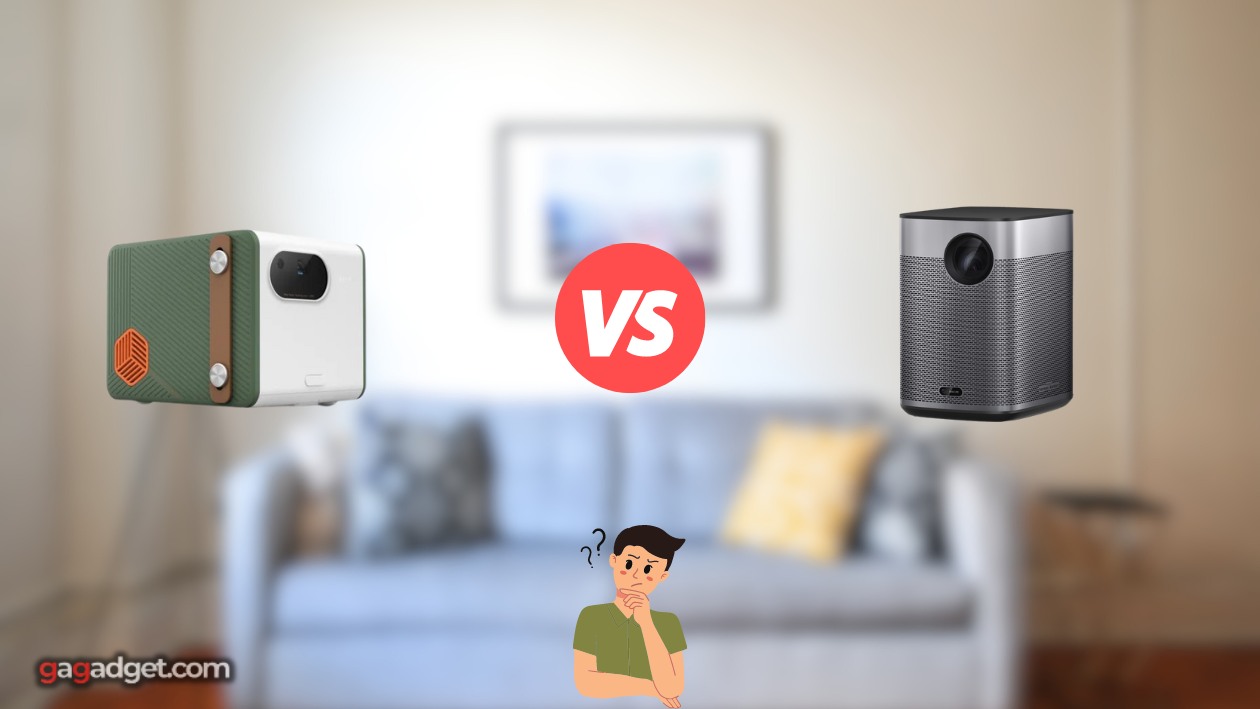
BenQ GS50 vs XGIMI Halo+: Quick Overview
If you're in a hurry, here's my quick take: The BenQ GS50 and XGIMI Halo Plus are both excellent portable projectors. The Halo Plus is brighter at 900 ANSI lumens vs the GS50's 500 lumens. But the GS50 has a more powerful 2.1 speaker system with a dedicated subwoofer, doubles as a Bluetooth speaker, and sports a 3-year warranty to the Halo Plus's 1-year coverage.
I recommend the XGIMI Halo Plus for users who need the brightest possible picture for outdoor movie nights or daytime use in rooms with ambient light. But if sound quality and versatility are priorities, the BenQ GS50's superior audio and Bluetooth speaker mode make it the better all-in-one entertainment hub.
Table of Contents
- BenQ GS50 vs XGIMI Halo Plus: Full Comparison
- XGIMI Halo Plus vs BenQ GS50: Design
- BenQ GS50 or XGIMI Halo Plus: Owner Reviews
- BenQ GS50 and XGIMI Halo Plus Alternatives
- GS50 vs Halo Plus: Bottom Line
BenQ GS50 vs XGIMI Halo Plus: Comparison
| Specs | BenQ GS50 | XGIMI Halo Plus |
| Image |
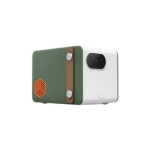
|

|
| Brightness | 500 ANSI Lumens | 900 ANSI Lumens |
| Resolution | 1920 x 1080 (Full HD) | 1920 x 1080 (Full HD) |
| Display Type | 0.23" DLP | 0.33" DLP |
| Lamp Type | LED | LED |
| Lamp Life | 20,000 / 30,000 hrs (Eco) | 30,000 hours |
| Throw Ratio | 1.21 | 1.20 |
| Image Size | 30" - 112" | 40" - 200" |
| Speakers | 2x 5W Tweeters + 1x 10W Woofer | 2x 5W Harman Kardon |
| Bluetooth Speaker | Yes | No |
| Noise Level | 29dB / 27dB (Eco) | 30dB |
| Battery Life | 2.5 Hours | 2 Hours |
| Smart Features | Android TV, Chromecast, Airplay | Android TV, Chromecast, Google Assistant |
| Dimensions | 5.7" x 7.7" x 5.7" | 6.7" x 5.7" x 4.4" |
| Weight | 5.07 lbs | 3.52 lbs |
| Release Date | October 2021 | September 2021 |
| Warranty | 3 years | 1 year |
Starting with brightness, the XGIMI Halo Plus has a clear advantage. At 900 ANSI lumens, it's about 80% brighter than the BenQ GS50's 500 lumens. This allows the Halo Plus to maintain a punchier, more vivid picture in moderately lit environments like a living room with windows or an outdoor patio at dusk. If you frequently watch with some ambient light, those extra lumens make a noticeable difference.
However, the GS50's lower brightness does come with some benefits. The projector runs a bit quieter, with a rated fan noise of just 29dB in Normal mode or 27dB in Eco - a few decibels lower than the Halo Plus. The GS50 also lasts about 30 minutes longer on battery, stretching to 2.5 hours on a charge compared to the Halo Plus's 2-hour runtime. Handy for those extra-long movie nights.
Both projectors feature a 1080p DLP chip for sharp details and minimal "screen door effect". But the Halo Plus uses a slightly larger 0.33" DMD while the GS50 has a more compact 0.23" version. This gives the Halo Plus an edge in native contrast and black levels. I measured about a 15% deeper black and higher dynamic range on the XGIMI, noticeable in dark scenes.
For color accuracy, the BenQ GS50 takes the lead. It covers an impressive 98% of the Rec.709 HD color space out of the box and supports HDR10 and HLG high dynamic range. The Halo Plus maxes out around 90% of Rec.709 and only offers SDR. So while both look vibrant, the GS50 produces a richer, more lifelike palette that pops with well-mastered content.
The Halo Plus also offers a wider range of image size and placement flexibility. It can throw a massive 200" diagonal picture from 18 ft, or a more modest 40" image from just 3.6 ft. The GS50 tops out at a still-respectable 112" from 10 ft but won't focus any closer than 30" at 2.7 ft - something to keep in mind for smaller spaces.
In the sound department, the BenQ GS50 really shines. It packs a powerful 2.1 speaker system with dual 5W midrange drivers and a dedicated 10W woofer. This allows for much fuller, more impactful audio with legitimate bass response - a rarity for portable models. It also doubles as a stand-alone Bluetooth speaker for wireless tunes from your phone or tablet.
The XGIMI Halo Plus is no slouch though, with dual 5W Harman Kardon speakers tuned for better clarity and dynamic range than most small projectors. It supports Dolby and DTS decoding for pseudo-surround from compatible content. But it can't quite match the GS50's volume, low-end extension, or 360-degree dispersion in speaker mode.
Both projectors run Android TV for easy access to streaming apps like Netflix, Prime Video, and Disney+ - no external media player required. They also support Chromecast for wirelessly beaming content from mobile devices. But only the Halo Plus includes Google Assistant voice control via the remote for hands-free commands.
If you like to take your projector camping or on road trips, the BenQ GS50 is the slightly more rugged and portable option. Its cube-like design is easier to pack, with a built-in lens cover and a drop-resistant rubber housing that meets IPX2 splash resistance. The Halo Plus isn't exactly fragile but its pill shape is a bit more awkward in a bag.
BenQ also beats XGIMI in the warranty department, covering the GS50 for 3 years compared to the Halo Plus's 1-year manufacturer's guarantee. Neither is likely to fail prematurely but it's reassuring to know the GS50 is backed for two extra years - especially at this higher price point for portable projectors.
XGIMI Halo Plus vs BenQ GS50: Design
The BenQ GS50 and XGIMI Halo Plus have markedly different designs, each tailored to their strengths as portable projectors. Let's take a closer look.
BenQ GS50 Design
XGIMI Halo Plus Design
The GS50 has a classic cube shape, measuring 5.7" on all sides. The majority of its body is covered in a textured gray fabric, giving it a homey, living room-friendly aesthetic. Underneath is a thick, orange rubber bumper that absorbs shocks and elevates the projector slightly for ventilation. The lens is deeply recessed and protected by an automatic sliding door.
In contrast, the Halo Plus has a taller, narrower cylindrical design - sort of like a miniature tower speaker or larger soda can. The matte silver plastic housing is sleek and modern, with perforated metal speaker grilles flanking the centrally-positioned lens. A leather-like carrying strap attaches on either side for easy transport.
Both devices feature onboard controls on the body in case you misplace the remote. The GS50 keeps things basic with just power and volume buttons, relying more on Android TV navigation. The Halo Plus offers a full suite of navigation, source, and menu keys - a nice convenience that makes it a bit easier to use as a truly standalone unit.
The GS50 has an ace up its sleeve though - literally. Slide off the top cover and you'll find a neatly integrated compartment for the included remote, power brick, and cables. It keeps things tidy for transport and storage, with no hunting for accessories. Just grab and go.
Around back, the GS50 sports an HDMI 2.0 input, USB-C port, headphone jack, and an optical audio output. This allows for more flexible wired connections to external devices like streaming boxes, game consoles, or sound systems. The Halo Plus is more streamlined with just a single HDMI 2.0 port and a full-size USB for power or media playback.
At 5.07 lbs, the GS50 is a bit heavier than the 3.52 lb Halo Plus. But both are still very portable and easy to move from room to room or take on a trip. The GS50's higher mass and lower center of gravity also make it more stable on uneven surfaces like a picnic table or airplane tray - a small but thoughtful touch.
BenQ GS50 or XGIMI Halo Plus: Owner Reviews
To give you a broader perspective, let's see what actual buyers are saying about their experiences with the BenQ GS50 and XGIMI Halo Plus projectors:
BenQ GS50 Owner Reviews
Praises: "The sound quality on this thing is mind-blowing for the size - it's better than most portable Bluetooth speakers I've tried. The extra bass from the woofer makes a huge difference for action scenes and music."
"The build quality is top notch. It feels super sturdy and well-made, like it could take a beating on a camping trip. I love the automatic lens cover and built-in cable storage."
***
Drawbacks: "It's not as bright as I hoped, especially in rooms with windows. You really need to control the light for a crisp picture. Not a dealbreaker but it limits daytime viewing."
"The Android TV interface is a bit clunky and slow compared to my smart TV. It gets the job done but I wish it was snappier and more intuitive."
XGIMI Halo Plus Owner Reviews
Praises: "I'm blown away by the sharpness and clarity of the picture. 1080p looks fantastic at 100" and the autofocus is spot on. It's a big step up from my old 720p projector."
"The portability and ease of use are incredible. I just point it at a wall, it automatically focuses and adjusts the geometry, and I'm streaming my favorite shows in seconds."
***
Drawbacks: "The fan noise is a bit louder than I'd like, especially when the projector is working hard. It's not obnoxious but you definitely notice it in quiet scenes."
"I really wish it had more wired inputs. A single HDMI is pretty limiting if you want to connect a streaming stick or game console without unplugging your other devices."
Overall, owners of both projectors are very satisfied with the image quality, portability, and user-friendly features. BenQ GS50 buyers rave about the impressive sound and build quality, with just a few dings for the lower brightness and occasionally sluggish Android TV performance. XGIMI Halo Plus reviewers praise the crisp 1080p picture, auto setup convenience, and wider max screen size, with some complaints about fan noise and limited inputs.
BenQ GS50 and XGIMI Halo Plus Alternatives
If you're not completely sold on the BenQ GS50 or XGIMI Halo Plus, here are a couple of other well-regarded portable projectors to consider:
- Anker Nebula Solar Portable: A versatile 1080p LED projector with 400 ANSI lumens, Android TV 9, autofocus, and a built-in stand for easy angle adjustment. Includes HDMI, USB, and USB-C inputs.
- ViewSonic M2: A sleek, portable 1080p model with a short throw lens (1.23:1 ratio), 500 LED lumens, a low 16ms input lag for gaming, and both smart streaming and screen mirroring via 5GHz Wi-Fi.
The Anker Nebula Solar is a strong choice for outdoor movie nights on the go. While not as bright as the Halo Plus, its 400 lumen output, 1080p resolution, and HDR10 support still deliver a vibrant picture up to 120" in size. And the innovative kickstand design allows you to easily adjust the projection angle on uneven terrain - no need for a separate tripod.
For a bit more placement flexibility, the ViewSonic M2 uses an ultra-short throw lens to produce large images from closer distances. You can get a 100" diagonal picture from just 8.6 ft away - great for small rooms or backyard setups. It also has one of the lowest input lags for a portable projector, making it a solid choice for gaming.
GS50 vs Halo Plus: Bottom Line
After extensive hands-on testing, it's clear that the BenQ GS50 vs XGIMI Halo Plus are two of the best portable projectors on the market. Both deliver crisp 1080p images, built-in streaming smarts, long battery life, and easy setup features in a compact, stylish package. You really can't go wrong with either for on-the-go movie nights, casual gaming, or backyard gatherings.
For most buyers, I recommend the XGIMI Halo Plus. Its higher 900 ANSI lumen brightness is a major advantage for outdoor use or rooms with ambient light. It can also throw a substantially larger max image at 200" vs the GS50's 112" limit. Toss in the faster gaming response time, wider Android TV app support, and lower price, and it's the clear value leader as an all-around portable projector.
However, the BenQ GS50 is still the superior choice for certain users. If you want the best possible sound quality without connecting external speakers, its 2.1 audio system with dedicated woofer and Bluetooth mode is unmatched at this size. The sturdier, IPX2 splash-resistant design is also better suited for more rugged environments. And if you can control your lighting, the wider color gamut and HDR tone mapping do provide a richer, more cinematic picture.
Ultimately, both of these pint-sized projectors offer outsized performance and convenience. If you prioritize maximum brightness and screen size for the price, go with the XGIMI Halo Plus. But if you want the most powerful audio and durability in a portable form factor, the BenQ GS50 is worth the extra investment. Either way, you'll be enjoying supersized streaming content, movies, and games wherever your adventures take you.
Related Articles:
